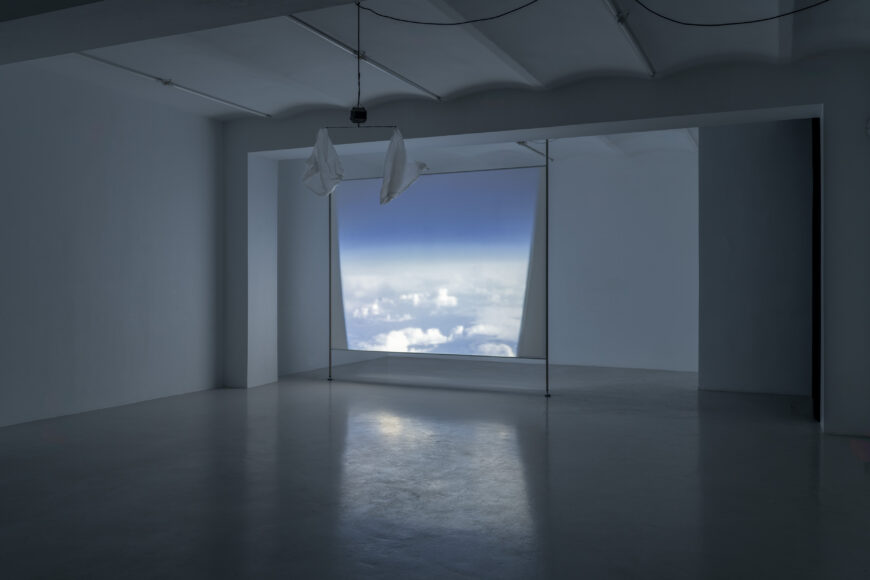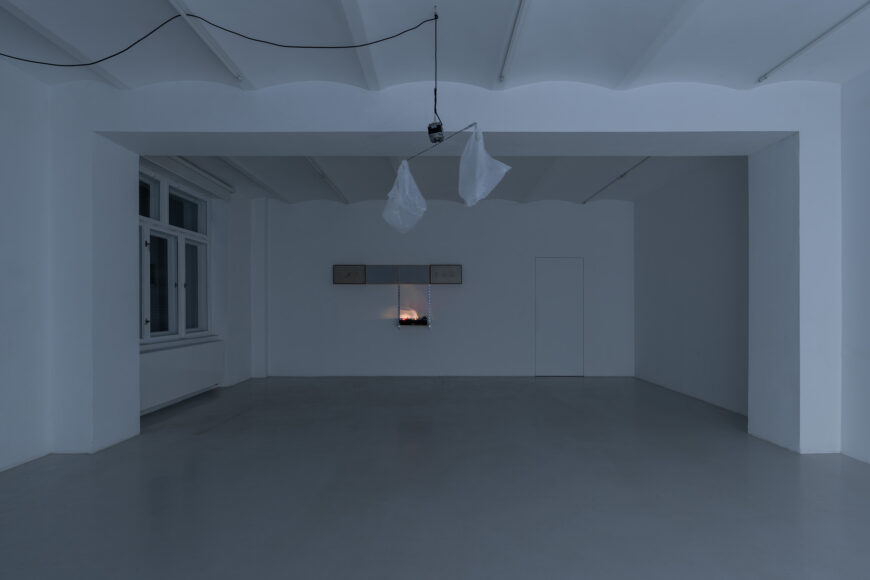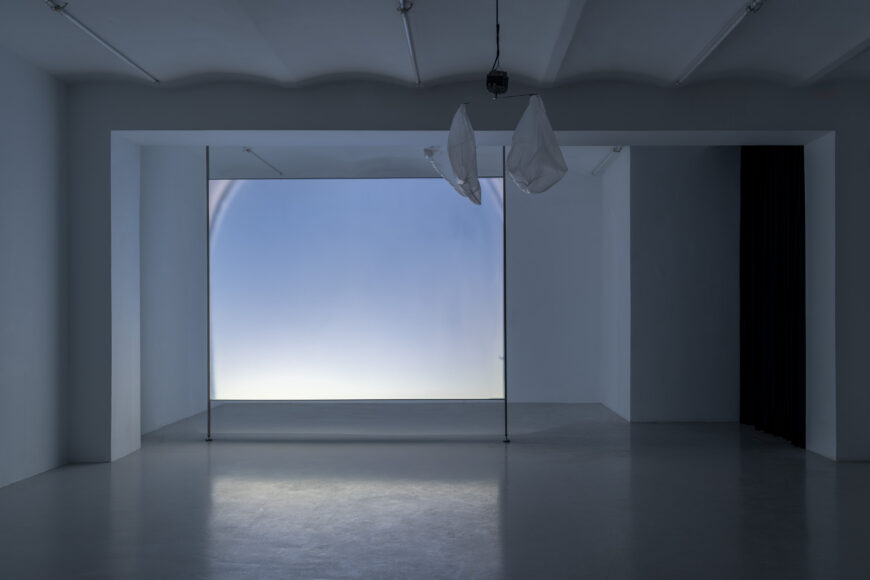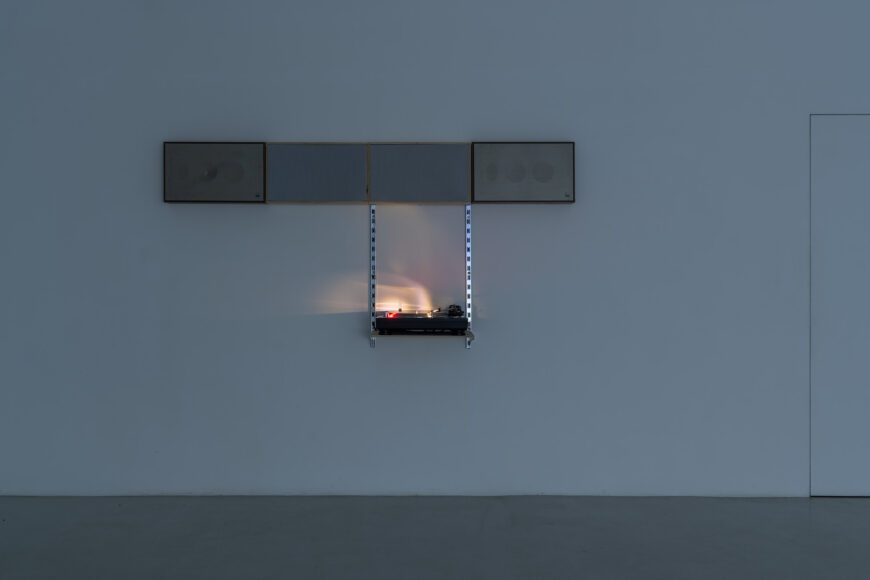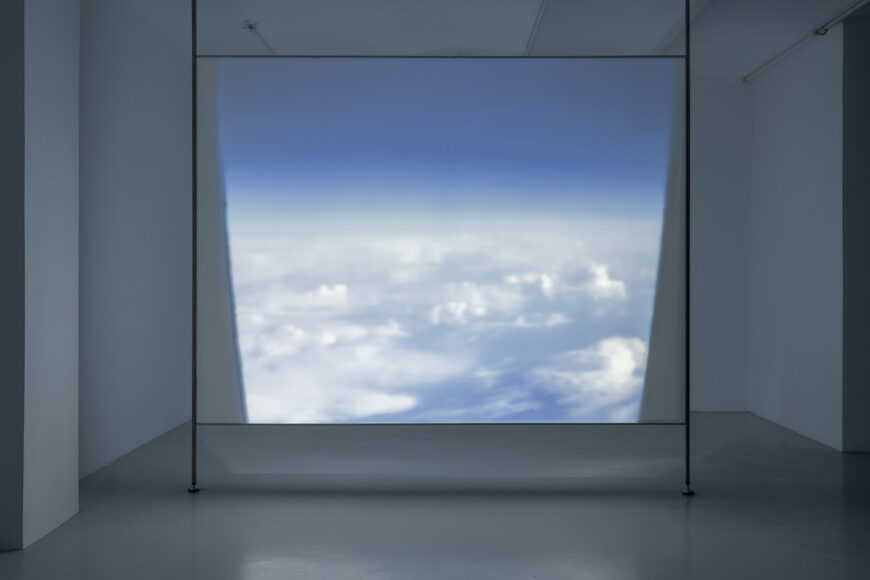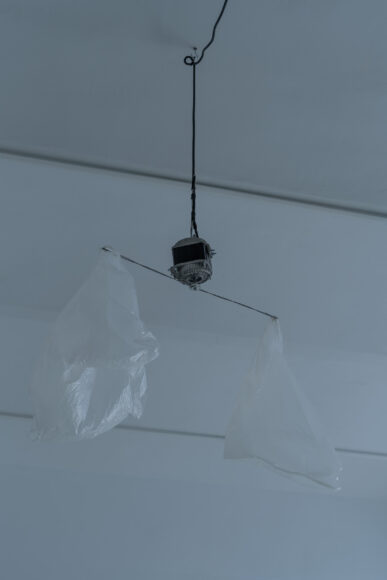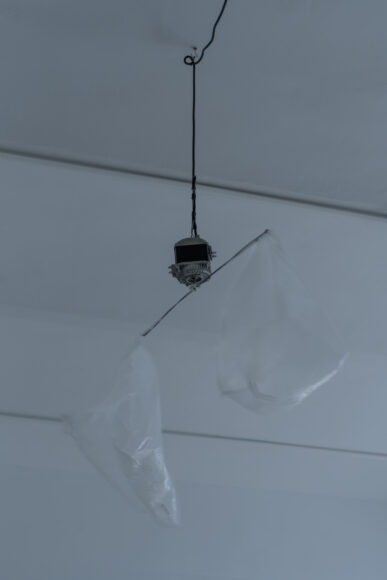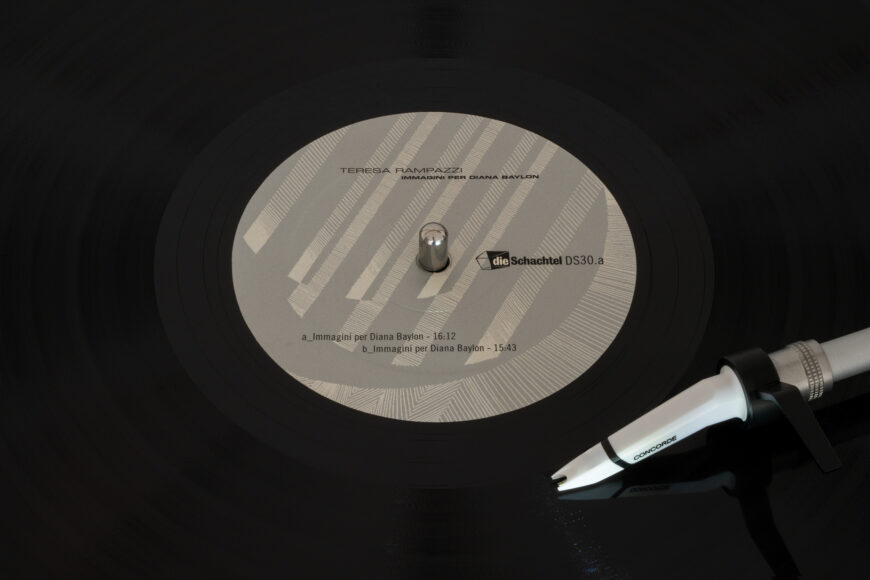Monika Sosnowska, Teresa Rampazzi, Wilhelm SasnalFree-drifters 3—30.8.2025
You are welcome to see the exhibition on the following days:
3 August, Sunday 11 am—2 pm
4—9 August, Monday—Saturday from 11 am—4 pm
14—16 August, Thursday—Saturday from 11 am—4 pm
17 August, Sunday from 11 am—2 pm
19—23 August, Tuesday—Saturday 11 am—4 pm
24 August, Sunday 11 am—2 pm
26—30 August, Tuesday—Saturday 11 am—4 pm
Intercome: 51 Galeria Skala
An artwork can become unmoored from its original intent, set adrift by time, technological change, or a simple act of preservation. When this happens, it enters a new state of being—an emergent afterlife where it operates according to its own quiet logic. Free-drifters brings together three stories of objects and artistic intention, with works that explore the mechanics of presence, memory, and agency that spread into forms of growths and sprouts.
The surviving 31-minute fragment of Teresa Rampazzi’s Immagini per Diana Baylon is a sonic remnant, an echo detached from its 180-minute body. The vast absence of the remaining 148 minutes is not a void but a shaping force, lending the present piece its profound and melancholic weight. A pioneer who once sold her piano to finance analog synthesizers, Rampazzi understood that electronic sound is inherently mutable. This piece, now circulating as a digital file, has been untethered from its 1972 context, becoming a ghost in a new machine, its looped existence a quiet meditation on technological memory and loss. Rampazzi herself described the visual art that inspired her piece in poetic, paradoxical terms:
„In her later artworks, the objects of Diana Baylon are definitely taking flight — as if they had just gone through dense layers of atmosphere… already whirling into space, but with an elegance that seems almost too excessive and smug — although ‘Mozart-like’ and free. Now the discourse is harder — from the profane to the sacred. You cannot dance anymore between being and not being. We are simply already in flight… light beams pass through the atmosphere which is itself light — nothing holds them — only the limits of a perfect geometry… so fast that it appears stationary… It is not disconnected from us — we understand it.”
Wilhelm Sasnal’s Concorde presents a digital ghost born from a program of self-destruction. The work was conceived as an 8mm film loop that would be systematically erased by a sandpaper-modified projector. Before its planned demise, a digital copy was made, creating an immortal twin that escaped its material fate. This version now exists in a state of permanent suspension, an image of an object in decay that can no longer decay. It is a post-futuristic artifact, forever preserved in the sterile amber of data and denied the closure of its own scripted ending. Sasnal described the original intent in a straight forward manner, leaving now room for hesitation:
“This film is a loop in which the film is supposed to wear itself out. In the frame, you see only the sky with a fragment of an airplane window. It is absolutely not visually attractive; it is meant to wear out completely.”
Two entities sharing the same space may coexist in symbiosis or parasitism, their relationship often defined by the subtleties of spatial interaction. Monika Sosnowska’s Fly Repellent stages such a relationship as a form of polite discouragement towards flies, while simultaneously operating as a proposition that seems to escape the circuits of supply and demand. By creating an object of function that serves no quantifiable purpose, the sculpture is ostensibly set free from the logic of mass-produced products; it will not be measured by sales data or optimized for market penetration. Yet, in a fascinating slippage, the work re-enters the system from another angle. Produced as a limited edition multiple of 35 for Parkett, it fully embraces the art market’s logic of scarcity and commodification. The autonomous machine, liberated from one form of capitalism, thus finds itself entangled in another, where its value is judged not by its utility, but by its status as a collectible artwork.
To frame the dialogue between the works of Rampazzi, Sasnal, and Sosnowska in terms of the “holding” phase (a waiting pattern in airspace) allows us to enter into the very condition the works themselves analyze. This phase represents a model state of operational suspension: an intermediate moment in which purposeful movement has ceased, the flight is no longer a journey from point A to point B, and the final landing procedure has not yet begun. It is within this very perspective, defined by looped movement and suspension, that the conversation drifts toward considerations on the state of being in displacement and transformation. The analysis of these states opens a field of reflection on incompleteness, the paradoxes of digital archiving, and the alternative trajectories of art objects. In these suspended states, where outdated technologies acquire new functions, the potential emerges to examine the subtle tensions between memory, matter, and the systems of art valuation.
Concorde, 2003, Wilhelm Sasnal, 7’39” Kodachrome / 8 mm, © Wilhelm Sasnal, courtesy of the artist and Foksal Gallery Foundation.
Fly Repellent, 2012, Monika Sosnowska, (for Parkett 91), two plastic bags, wire, electric motor, cable, 23 1/2” diameter. ©Monika Sosnowska, courtesy artist, Foksal Gallery Foundation and Parkett.
Immagini per Diana Baylon (1972) – A 31’50”, Teresa Rampazzi, stereophonic 31’50”, intended to be played in a loop. The original 180 minute long composition was created for Diana Baylon’s exhibition in 1972 at the “Il Fiore” modern art gallery in Florence. ©Teresa Rampazzi ©: SIAE Die Schachtel DS30 – 2016 Project by: Laura Zattra, Produced by: Fabio Carboni, Bruno Stucchi, Digitalization and Digital Archiving: Sergio Canazza, Mastering: Giuseppe Ielasi, Design: dinamomilano.com
Teresa Rampazzi (born in 1914 in Vicenza – died in 2001 in Bassano del Grappa) was an Italian pianist, composer, and educator, recognized as a pioneer of electronic and electroacoustic music in Italy, and the first Italian woman to produce and promote this art form. Born in Vicenza, she studied piano at the Milan Conservatory, graduating in 1933. In the 1950s, she became interested in avant-garde music, attending the Ferienkurse Darmstadt, where she first encountered a frequency generator, introduced by Herbert Eimert. Rampazzi was deeply convinced of the necessity of developing avant-garde music to prepare the public for Neue Musik and the new electronic paradigm. In February 1959, she gave a concert in Padua with John Cage, Heinz-Klaus Metzger, and Sylvano Bussotti. Dedicating herself to electronic music at the age of 50, she sold her piano (which her husband later repurchased) and, in 1965, co-founded the NPS Group (Nuove Proposte Sonore) with Ennio Chiggio, an experimental collective researching sound generation using analog devices. This group became one of the main active studios in Italy. In the 1970s, Rampazzi undertook a residency at the Experimental Studio of Polish Radio in Warsaw, where she collaborated with sound engineer Bohdan Mazurek. This collaboration expanded her international network and resulted in several multi-track tape compositions. From 1972, Rampazzi took on the position of professor of electronic music at the Conservatory in Padua (one of the first electronic music courses in Italy), where she taught analog techniques. Simultaneously, from the early 1970s, she began working on computer music at the CSC (Centro di Sonologia Computazionale), receiving numerous awards. Her groundbreaking works include the 180-minute loop Immagini per Diana Baylon (1972, 31′50″ preserved), Musica Endoscopica (1972), Fluxus (1979), and Atmen noch (1980, distinction in Bourges). The re-discovered Rampazzi archive and recent scholarly attention ensure her place among the earliest European innovators in the field of electroacoustic sound art. She continued to compose after retiring in 1984 and relocating, and passed away in Bassano del Grappa in 2001.
Wilhelm Sasnal (born 1972 in Tarnów), an artist living and working in Krakow, is a painter, draftsman, filmmaker, and comic book artist. He studied architecture at the Krakow University of Technology (1992-1994), and then painting at the Academy of Fine Arts in Krakow (1994-1999), where he received his diploma in Professor Leszek Misiak’s studio. In 1996, he co-founded the now-defunct Grupa Ładnie. Sasnal is considered by critics to be one of the most important artists of the younger generation, and his works are part of the canon of new European painting of the early 21st century, inspiring many followers. In 2006, he received the prestigious Vincent van Gogh Award and was ranked first among the most important young artists in the world by “Flash Art” magazine. For Sasnal, contemporary life and everyday existence are primary inspirations – events, people, music, books, comics, and photographs. His paintings are characterized by extraordinary synthesis and brevity, with flatly applied colors, which gives them a poster-like and modern form. Early canvases, referred to as pop-banalism, transferred subjects from trivial daily life and media onto the canvas. The artist creates a kind of chronicle of contemporaneity, painting mundane objects that gain the status of signs of the times, while simultaneously engaging in dialogue with history, including events significant to human history. In terms of filmmaking, Sasnal, who has directed several feature films in collaboration with his wife Anka, is faithful to traditional 8 and 16 mm film stock due to the specific effects and projection methods, and his films often take the form of poetic images without a plot, with music as a significant element. Sasnal’s works are held in the collections of many important museums and private collections, including New York’s MoMA, Centre Pompidou in Paris, and Tate Modern in London. The artist has participated in significant individual and group exhibitions, as well as the 5th Berlin Biennale (2008) and the 31st International São Paulo Biennial of Contemporary Art (2014).
Monika Sosnowska (born 1972 in Ryki), living and working in Warsaw, is an acclaimed sculptor, a graduate of the Academy of Fine Arts in Poznań and the Rijksakademie van Beeldende Kunsten in Amsterdam. Her work focuses on large-scale, site-specific architectural installations, created by appropriating and manipulating construction materials such as steel beams, concrete, rods, and pipes. These impactful and elegant sculptures challenge the viewer’s perception, and their specificity and impermanence are integral to her work. Sosnowska gained early recognition, winning the Bâloise Art Prize and Paszport Polityki in 2003, and representing Poland at the 52nd Venice Art Biennale in 2007 with her project 1:1. In her artistic practice, the artist explores the interplay of architectural and mental space in a formally minimalist and conceptual sculptural language. Sosnowska’s works refer to modernism and its utopian ideals, with particular emphasis on their architectural application and impact in Poland and other Eastern European countries. By distorting and reassembling architectural materials, Sosnowska challenges the rational paradigm of modernism, while simultaneously creating visual puzzles and optical illusions. Her works often analyze architecture through the lens of failures and absurd realizations, functioning as abstracted relics of urban utopias. She draws inspiration from the experiences of post-war modernization and the concrete heritage rooted in the Athens Charter, as well as from Polish constructivism of the 1930s, minimalism and conceptual art of the 1960s and 1970s, and the aesthetics of the Polish People’s Republic era (PRL). Sosnowska’s works have been widely exhibited in prestigious institutions worldwide over the last two decades.
